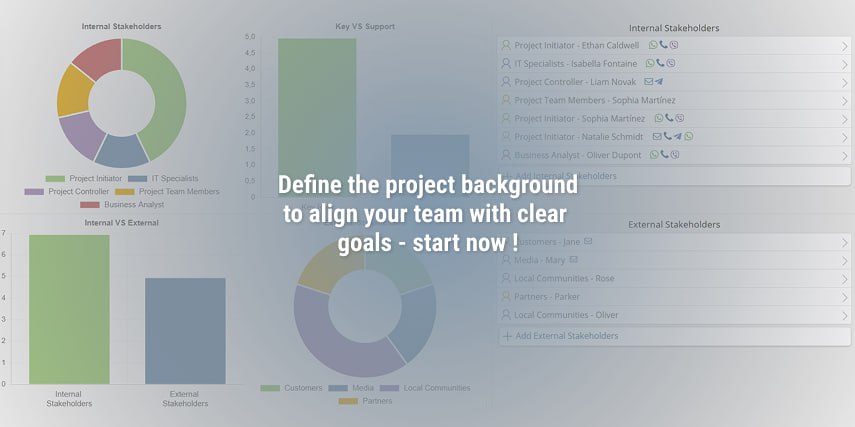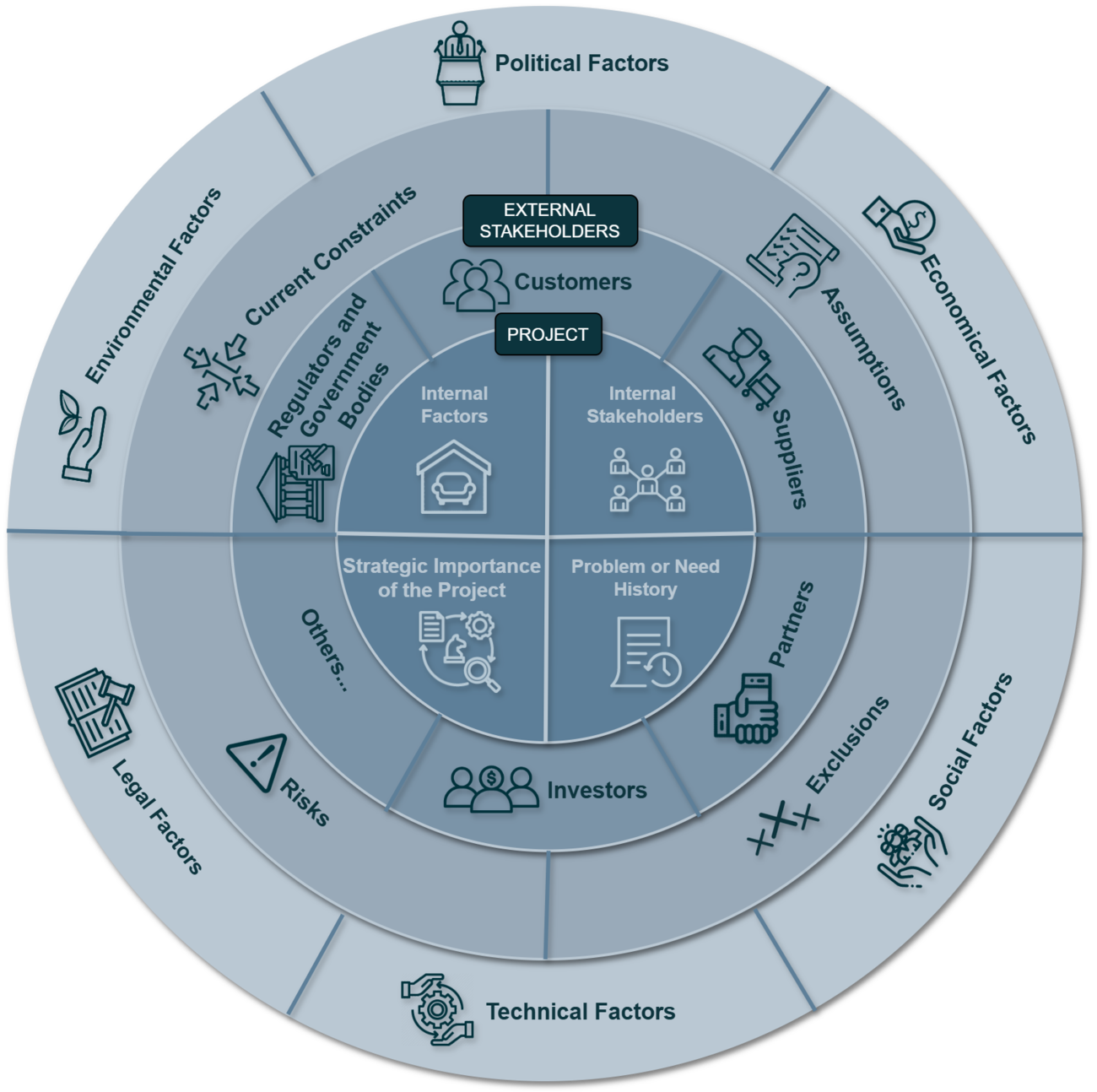Topic Definitions #
Project Background #
the second step in project management, vision , mission, strategy, and goals. At this stage, teams analyze current conditions, assess potential challenges, and identify opportunities that justify the project’s initiation. Clearly defining the background ensures that all participants understand the context and motivations behind the project. As a result, misunderstandings are minimized, and the focus remains on achieving the final objectives.
Project Stakeholders #
that influence or are influenced by a project’s results. They are categorized into internal and external groups.
• Internal stakeholders operate within the company, including project managers, employees, and departments that allocate resources.
• External stakeholders: consist of clients, suppliers, investors, regulatory agencies, and local communities that engage with the project in varying capacities.
Since each stakeholder possesses unique expectations and levels of involvement, their influence varies. Some actively shape decisions, such as project sponsors, while others observe passively but remain affected by the outcomes. Acknowledging their perspectives fosters collaboration, mitigates risks, and enhances overall project success.
Strategic Alignment #
Historical Analysis #

Performance Tracking #
Contextual Alignment #
Operational Efficiency #
Market Expansion #

Stakeholders and Their Roles #
Project stakeholders fulfill diverse roles that shape a project’s direction and outcome. These responsibilities range from decision-making to resource allocation. Explain the Background of each stakeholder group is essential for ensuring clarity and alignment.
Recognizing stakeholder roles enhances engagement, mitigates risks, and secures essential support throughout implementation. Below is an overview of key stakeholders.
Internal Stakeholders: These are directly involved participants within the company who influence project execution. They include departments, employees, or teams either contributing to or affected by the project.
Project Initiator: #
The individual or entity responsible for identifying a project need. This role involves recognizing opportunities within the organization or market and proposing solutions. While initiators play a crucial role at the project’s inception, their direct involvement often ends once formal initiation occurs.
Project Sponsor: #
A strategic role responsible for securing financial resources and ensuring project alignment with business goals. Sponsors hold decision-making authority, resolve conflicts, and oversee the project’s progress. Additionally, they play a key role in approving the project charter, defining the scope, and making crucial go/no-go decisions.
Project Manager: #
- Responsible for planning, managing, and successfully completing the project.
- Coordinates the team, resources, and processes to achieve the project’s goals.
Project Team Members: #
- Specialists working on the tasks of the project.
- Includes both technical personnel and administrative staff involved in the project implementation.
Program/Portfolio Manager: #
- Manages multiple projects or programs within a unified direction.
- Ensures the strategic alignment of all projects within the portfolio.
Functional Manager: #
- Manages the department or division that provides resources for the project.
- May control the project team or participate in resource management.
Financial Manager: #
- Responsible for budgeting, financial control, and ensuring timely project funding.
- Keeps financial records and analyzes costs.
PMO – Project Management Office: #
- A specialized division responsible for project management standards, methodologies, and team support.
- Oversees the project management process and alignment with the company’s strategy.
Key Users: #
- Employees who will use the project’s outcomes.
- Participate in requirements development and testing, providing feedback on the quality of solutions.
- IT Specialists:
- Responsible for technical support and integration of IT solutions into the project.
- May include developers, data engineers, system architects, and administrators.
- Quality Manager:
- Controls the quality of all stages of the project.
- Ensures compliance with established processes and requirements.
HR Manager: #
- Manages human resources within the project.
- Responsible for recruitment, training, and motivating project personnel
Business Analyst: #
- Evaluates business processes and identifies necessary improvements. Their role ensures that project outcomes align with strategic goals.
Risk Manager: #
- Oversees risk identification, assessment, and mitigation strategies. By monitoring risks, they safeguard the project’s success.
Procurement Manager: #
- Manages procurement activities, including supplier selection, contract negotiations, and logistics coordination. Their role ensures smooth resource acquisition.
Communications Manager: #
- Responsible for developing and implementing internal and external communication strategies in the project. Ensures regular stakeholder updates.
Resource Manager: #
- Manages human and material resources in the project. Ensures their effective allocation and utilization.
Configuration Manager: #
- Responsible for controlling and managing changes in project configuration. Ensures consistency of versions and documentation.
Project Controller: #
- Monitors the project’s progress, manages performance indicators, and assists the project manager with schedule and cost analysis.
Safety Engineer: #
- Ensures compliance with safety standards in the project, particularly if the project involves health and safety risks.
Technical Lead: #
- Oversees the technical aspects of the project, ensuring the correct implementation of technical solutions and integration of all system components.
Change Manager: #
- Manages the process of introducing changes to the project, tracking their impact on the overall project flow and stakeholders.
Test Manager: #
- Organizes and manages the testing process for project solutions and products. Ensures all tests are performed and the product’s quality is verified before release.
Solution Architect: #
- Develops architectural solutions and is responsible for the technical design of the project. Ensures the integration of all systems and alignment with business requirements.
System Administrator: #
- Responsible for configuring, supporting, and maintaining servers, databases, and other systems involved in the project.
Systems Analyst: #
- Analyzes requirements and develops technical solutions to meet the project’s objectives. Collaborates with business analysts and technical specialists.
User Support Manager: #
- Manages the user support process after project solutions are implemented. Ensures prompt problem resolution and user training.
By analyzing internal participants, project managers can build more efficient workflows and internal communications.
External stakeholders: These are individuals or entities outside the organization who significantly impact or are affected by project outcomes. Explain the Background of external influence provides better risk awareness and planning.
They may include:
Customers: #
The core audience for the project’s final product or service. Their requirements shape project goals and drive success.- Suppliers: Entities providing materials, equipment, or services. Their efficiency directly impacts project timelines, costs, and quality.
Partners: #
Strategic allies that contribute expertise or resources. Their collaboration enhances project feasibility and execution.Investors: #
- Individuals or companies that finance the project and expect a return on investment.
- They are interested in the project’s successful completion from a financial performance perspective.
Regulators and Government Bodies: #
- Organizations or agencies that ensure the project complies with legal and regulatory requirements.
- This includes certification bodies, safety inspectors, licensing authorities, and environmental agencies.
Auditors/Compliance: #
- External organizations that audit the project for compliance with standards, laws, and regulations.
- They may influence project adjustments through recommendations to improve processes.
Consultants: #
- External experts engaged to provide advisory services on specific aspects of the project.
- They assist with solving complex issues, offering new approaches and tools for successful project implementation.
Local Communities: #
- Groups of people living in areas where the project is being implemented.
- They may be interested in the project’s social and environmental aspects.
Media: #
- Media outlets that can influence public opinion and perceptions of the project.
- Their interest may relate to large-scale or socially significant projects.
Competitors: #
- Companies or organizations that may indirectly influence the project through competition.
- Their actions can change market dynamics and impact the project’s strategy.
NGOs and Advocacy Groups: #
- Non-governmental organizations or groups that may promote specific social or environmental goals.
- They can influence the project if it affects their interests.
Involving these stakeholders early ensures broader support and realistic expectations.
Stakeholders #
This section defines the key participants in the project, both within and outside the company.
A clear understanding of the stakeholders interests and expectations helps manage communications and increases the likelihood of success.
Organizational or Industry Context #
This section highlights key external factors that impact the company or industry at large. While these influences may not alter internal policies, they shape overall project feasibility. Explain the background of these industry-wide forces is critical for strategic alignment.
External Conditions #
This includes economic, legal, political, social, and technological factors that may impact the project. For example, changes in legislation, market trends, new technologies, the economic situation, or social shifts.
Market Position #
A brief analysis of the company’s current position in the market relative to competitors. It encompasses market share, brand perception, and unique value propositions. Explain the background here.
By assessing these factors, businesses can identify potential risks and opportunities, adjusting strategies accordingly.
Internal Factors #
This section focuses on the factors within the company that may influence the project.
-
Financial Resources #
A description of the current financial situation and available resources for project implementation project implementation.
-
Human Resources #
The availability and qualifications of the personnel involved in the project .
-
Organizational Structure and Culture #
The internal organizational culture and management structure that may affect the project’s success.
-
Resources and Infrastructure #
The material and intangible resources available for the project, including equipment, technology, and infrastructure.
To ensure realistic execution, it is necessary to explain the background of internal enablers and limitations.
Current Constraints, Assumptions, Exclusions and Risks #

This section explains the background of core factors that may influence project success, including constraints, assumptions, exclusions, and risks.
• Constraints:
Constraints are limitations in time, budget, or resources that define project boundaries.
Limited specialists or equipment;
Tight deadlines;
Budget caps restricting flexibility.
Early identification helps prioritize effectively.
• Assumptions:
Assumptions are conditions considered true during planning. Teams must explain the background to ensure clarity and alignment.
Resources will be available as planned;
Clients will deliver data on time;
No legislative changes will occur soon.
Continuous validation is essential.
• Exclusions:
Exclusions define what’s not included in the project. This prevents scope creep and sets clear expectations.
No support for legacy systems;
No post-launch scaling;
Maintenance excluded after delivery.
Documenting exclusions keeps focus sharp.
• Risks:
Risks are potential threats that could disrupt execution. It’s crucial to explain the background of each to assess and manage them properly.
Legal or regulatory changes;
Financial volatility;
Staff or equipment shortages.
Addressing risks early improves resilience.
Strategic Importance of the Project #
This section defines how the project aligns with broader business objectives. It should explain the background of strategic initiatives to reinforce priority.
Impact on the Business #
How the project will help achieve the company’s strategic objective, including operational efficiency, innovation, market expansion, and other critical aspects.
Potential Benefits #
The strategic advantages the project may bring, such as improving competitiveness or increasing profits. It also includes the development of new market opportunities.
A strategic framing improves executive buy-in and long-term planning.
Problem or Need History #
This section explains the background of why the project began in the first place.
This part is vital for contextual alignment and performance tracking.
Conclusion #
Understanding the roles of project stakeholders is fundamental to building a strong foundation for success. By identifying and explaining both internal and external contributors, project managers can foster engagement, prevent conflict, and align expectations.
Moreover, by explaining the background of both internal factors and external pressures, teams can plan more accurately and avoid unnecessary risks. When paired with strategic alignment and historical analysis, this approach ensures that the project is both grounded and future-focused.
Ultimately, a project with a clear background, stakeholder integration, and strategic importance is better positioned to deliver lasting business value.








